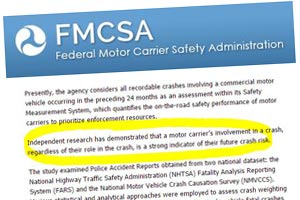FMCSA Study: Carrier Involvement in Crash Strong Indicator of Future Risk

About 91% of police accident reports contain enough information to determine fault in a truck-related crash, but assessing whether a truck and driver were at fault in a crash does not appear to improve the ability to predict crash risk when all crashes are considered, according to a long-awaited study unveiled by the Federal Motor Carrier Safety Administration.
“Independent research has demonstrated that a motor carrier’s involvement in a crash, regardless of their role in the crash, is a strong indicator of their future crash risk,” FMCSA said in announcing its findings Jan. 21.
In a statement, American Trucking Associations expressed its disappointment that FMCSA “continued its efforts to delay appropriate action on the important issue of crash accountability in its [Compliance, Safety, Accountability] program.”
“Numerous times over the past five years, ATA has respectfully requested FMCSA to screen out crashes from CSA where it is plainly evident the professional truck driver and motor carrier were not at fault,” ATA Executive Vice President Dave Osiecki said. “Instances where a truck is rear-ended by a drunk driver or hit head-on by a motorist traveling in the wrong direction on the interstate or, as happened just Monday, when a truck was struck by a collapsing bridge, are clearly not the fault of the professional driver and certainly should not be used to target his or her carrier for potentially intrusive government oversight.”
The study said that in an analysis of nearly 10,892 police accident reports (PARs), more than 9,884 generally provided reliable information on which to assess fault in an accident.
However, when the study compared data contained in police accident reports with information contained in the Fatality Analysis Reporting System (FARS), the two data sources were not always in agreement.
“The agency was unable, in this type of analysis, to establish which record, the PAR or FARS, was more accurate, but simply identified the fact that the two data sources were not always in agreement,” FMCSA said.
The purpose of the study was to examine three questions:
- Do police accident reports provide sufficient, consistent, and reliable information to support crash-weighting determinations?
- Would a crash-weighting determination process offer an even stronger predictor of crash risk than overall crash involvement, and how would crash-weighting be implemented in the Safety Measurement System (SMS)?
- Depending upon the analysis results for the questions above, how might FMCSA manage the process for making crash-weighting determinations, including public input to the process?
In answer to the last question, FMCSA said in the report the agency would have to set up a system with the states to collect and manage the police report data. Such a system could cost between $3.9 million and $11.2 million annually.
The study examined police accident reports obtained from two national datasets: the National Highway Traffic Safety Administration’s FARS and the National Motor Vehicle Crash Causation Survey, FMCSA said.
ATA Chairman Duane Long, chairman of Longistics, in Raleigh, North Carolina, added, “We want to be fairly judged and not be penalized by crashes our professional drivers could not reasonably avoid. It’s not only a fairness issue, it’s a good government oversight approach. We continue to trust FMCSA might eventually arrive at this conclusion.”

